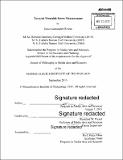Towards wearable stress measurement
Author(s)
Hernandez Rivera, Javier
DownloadFull printable version (25.66Mb)
Other Contributors
Massachusetts Institute of Technology. Department of Architecture. Program in Media Arts and Sciences.
Advisor
Rosalind W. Picard.
Terms of use
Metadata
Show full item recordAbstract
Chronic psychological stress carries a wide array of pathophysiological risks, including cardiovascular and cerebrovascular diseases, diabetes, and immune dysregulation. An important step in managing stress, before it becomes chronic, is recognizing precisely when and where it occurs. This thesis creates and evaluates new methods to improve the measurement of stress by leveraging state-of-the-art wearable devices. The first part of the thesis systematically compares gathering self-reported stress levels with head and wrist-worn devices, and compares them to the traditional cellphone in the pocket. In particular, 15 participants were asked to carry these devices during five days of their regular work day and to self-report their emotional state several times a day with our custom experience sampling application. We found that both head and wrist-worn devices significantly outperformed the phone in terms of the amount of answered prompts and the speed to start answering. However, different factors such as interaction types, screen size, and familiarity with the devices affected users' experience and responses. The second part of the thesis develops novel methods to comfortably capture physiological signals associated with the stress response. In particular, 36 participants were asked to carry either a head-worn device, a smartwatch or a smartphone while performing different "still" body postures in a controlled laboratory study. Using the proposed methods, we demonstrated that wearable motion-sensitive sensors inside these devices can capture heart and breathing rates as accurately as FDA-cleared devices from traditional body locations. Furthermore, using the data collected from the 15 participants, we demonstrated that our methods can be opportunistically used in real-life when people are relatively "still. " In our study, for instance, the head-worn device provided accurate heart rate assessments around 20% of the work day. Finally, the third part of the thesis uses supervised learning methods to automatically infer self-reported stress levels from different types of wearable data, including physiological, contextual and behavioral signals. While there is not a one-size-fits-all solution, we found that electrodermal activity, head motion and atmospheric pressure were the more relevant signals across the 15 participants. Furthermore, we characterized many of the challenges that plague the task of real-life stress recognition.
Description
Thesis: Ph. D., Massachusetts Institute of Technology, School of Architecture and Planning, Program in Media Arts and Sciences, 2015. Cataloged from PDF version of thesis. Includes bibliographical references (pages 206-220).
Date issued
2015Department
Program in Media Arts and Sciences (Massachusetts Institute of Technology)Publisher
Massachusetts Institute of Technology
Keywords
Architecture. Program in Media Arts and Sciences.